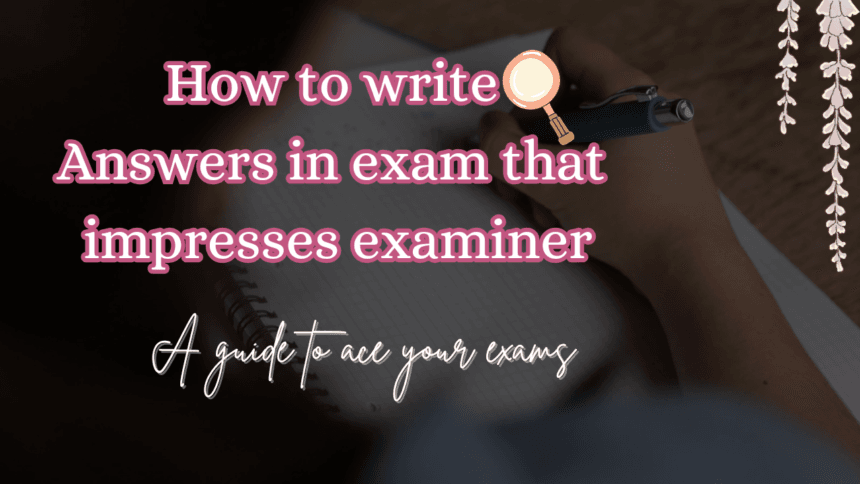Writing responses that impress examiner requires not just knowledge of the subject matter, but also excellent presentation.
Many students fail to structure their comments, use appropriate terms, and retain clarity.
This article offers practical advice and tactics for writing well-structured, compelling responses that will help you optimize your score.
Understand the question properly
A significant error students do is misinterpreting the question and adding superfluous material.
Before responding, spend a few seconds considering the question.
Important Tips: Identify terms such as explain, describe, compare, justify, and analyse.
Understand the marks assigned – longer replies for high-scoring questions, shorter responses for short ones.
To guarantee clarity, rephrase the question mentally.
For example, if the question is, “Explain Newton’s first law with an example,” don’t just describe it; provide an example and expound.
Structure your answers clearly
A well-structured response is simple to read and impresses the examiner.
Use an organized method for long-answer questions:
For theoretical subjects: Steps: introduction, explanation, example, and conclusion.
For Numerical and Problem Solving Questions: Formula: Given Data → Calculation → Final Answer (Boxed)
Example of a history question: Introduction: A brief description of the incident. Main Body: Explain the causes, consequences, and relevance.
Conclusion: Summarize in one or two lines. A correct format improves readability and helps your solution stand out.

Use proper formatting and presentation
Even if your response is correct, bad presentation might result in lost scores.
An ordered response sheet makes it easy for examiners to evaluate.
Best practices: Write in points and paragraphs (rather than continuous, uninterrupted prose).
Use headers, subheadings, and bullet points when appropriate.
Underline significant words and use bold for formulae.
Leave enough space between replies for clarification.
To increase readability, divide up a long paragraph into numbered points or small paragraphs.
Use simple and precise language
Avoid using unnecessarily complicated terminology or long phrases it create a bad impression on the examiner.
Make sure your wording is precise, succinct, and to the point.
How Could you Improve Clarity?
Use short, straightforward phrases.
Avoid excessive repetition.
Define technical words as necessary. Use active voice rather than passive voice.
For example: Instead of stating, “It is observed that photosynthesis is the process by which plants prepare their own food by using sunlight, water, and carbon dioxide,” simply state, “Photosynthesis helps plants make food using sunlight, water, and carbon dioxide.”
Use Diagrams and flowcharts
A well-labeled diagram or flowchart can earn extra points and clarify explanations, particularly in areas such as science, geography, and economics.
How to Use Them Effectively?
Create clear, crisp, labeled diagrams. Use flowcharts for step-by-step procedures.
If time is limited, draw a rudimentary graphic but make it obvious.
For example, for a Biology response on “The Human Digestive System,” a well-drawn picture might get more marks than simple text.
Support your answer wih example
Examiners like responses that incorporate real-life examples, case studies, or historical references.
This demonstrates a more in-depth comprehension of the issue.
Example Usage: In science, use real-world examples to demonstrate laws or concepts.
In economics, refer to current market trends or government policy.
Compare historical events to modern-day circumstances.
For example, if you’re asked about “The Impact of Climate Change,” highlighting recent incidents like rising sea levels or harsh weather conditions will help you respond more effectively.
Answer in the expected word limit
Writing too much or too little might result in losing marks.
Examiners anticipate replies within a fair timeframe.
How to Stay Within Word Limit?
For 2-3 mark questions, respond in 2-4 clear words.
In 5-mark questions, use concise paragraphs with examples.
For 10-mark questions, provide a well-structured solution that includes an introduction, explanation, and conclusion.
Tip: If you’re running short of time, write important points rather than extensive explanations.
Manage your time wisely
Time management is critical in tests. Avoid focusing too much on one question while leaving others unfilled.
Best Time Management Strategy: First, skim the paper and answer the easiest questions.
Determine how much time each question should take based on its score.
Allow 10-15 minutes at the end to examine answers and repair errors.
For example, if the test lasts three hours and consists of ten questions, allow 15-18 minutes each question to guarantee that all are attempted.

Avoid common mistakes
Many students lose scores for preventable blunders such as:
Filling up blank spaces with unnecessary content.
Using terrible handwriting (if the examiner finds it difficult to read, you will lose marks).
Answers are not numbered appropriately.
Ignore grammatical and spelling mistakes.
Tip: Always proofread your response before proceeding to the following question.
Attempt all questions
Even if you are doubtful, answer each question rather than leaving it blank.
A partially right response might still win you some points.
For example, if you forget a math formula, jot down related concepts or an illustration; you may receive half credit.
Remain Calm and Confident
Your perspective has a major impact on examiner as how well you perform.
If you panic, you could forget all you know.
Exam Day Tips: Take a big breath before beginning. Before replying, read over the full document.
Trust your preparations and avoid last-minute cramming.
Conclusion
Writing compelling responses requires clarity, organization, presentation, and relevancy.
By implementing these 11 effective tactics, you may improve your grades and make a good impression on the examiner.
Also check, healthy foods for exam









